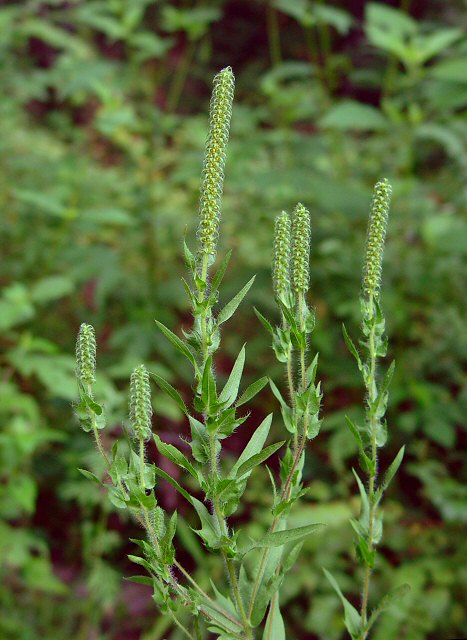Ambrosia bidentata Michx.
Lanceleaf Ragweed

Native
CC = 0
CW = 5
MOC = 70
© DETenaglia
Ambrosia bidentata Michx.Lanceleaf Ragweed | |
 |
Native CC = 0 CW = 5 MOC = 70 |
© DETenaglia |
|
Family - Asteraceae/Heliantheae Habit - Taprooted annual.
Stems - Ascending to erect, to 1 m, roughened-pubescent with mixed hairs, some of these with pustular bases, sometimes glabrous near the base, often somewhat shiny.
Leaves - Mostly alternate (the lowermost occasionally opposite), sessile. Leaf blades 1-7 cm long, 0.4-1.0 cm wide, lanceolate, unlobed or with a pair of small lobes toward the base, the lobes triangular, the margins otherwise entire, the surfaces sparsely to moderately roughened-pubescent with short, loosely ascending, pustular-based hairs and stiff, longer hairs (mostly along the midvein), the upper surface sometimes only sparsely hairy, the undersurface often with small, sessile glands (slightly sticky to the touch), not or only slightly paler than the upper surface.
Inflorescence - Staminate heads sessile in relatively dense, solitary spikes, the staminate involucre 2.5-4.0 mm wide, with 3 lobes, the lateral ones small, the terminal lobe elongate, the outer surface with minute, sessile glands, the terminal lobe with a patch of relatively long, stiff hairs. Pistillate heads in small axillary clusters, the involucre enclosing 1 floret and with 1 stout, conical beak, 5-8 mm long at fruiting, more or less ovoid, with usually 4 longitudinal angles or ridges, each terminating in a short spine, moderately hairy.
Flowers - Staminate heads with 10-150 disc florets, the stamens with the filaments fused into a tube, the anthers free but adjacent to one another in a ring, the corolla 2-4 mm long, narrowly bell-shaped, white to pale yellow, sometimes purplish-tinged toward the tip, usually minutely hairy and often also glandular. Pistillate heads with 1 or 2 florets, the corolla absent. Pappus absent.
Fruits - Fruits 3.0-4.5 mm long, globose to ovoid, grayish tan to nearly black, glabrous, completely enclosed in the persistent pistillate involucre and dispersed as an intact bur. Flowering - July - October. Habitat - Prairies, fields, waste ground, pond margins, pastures, roadsides, railroads. Origin - Native to the U.S. Other info. - This weedy species is common throughout most of Missouri except for the northwest corner of the state. Its natural range is centered in the Missouri-Arkansas region and extends to a few adjoining states. The plant is easy to identify in the field because of the sharply pointed basal lobes present on many of the leaves, and its terminal spikes of staminate flowers. Like the other species in this genus, this plant is a cause of hay fever in the fall. Photographs taken off Hwy 60, Carter County, MO., 8-31-03, and at Big Spring, MO., 8-3-04 (DETenaglia); also at Canaan Conservation Area, Gasconade County, MO, 8-13-2013, and Glade Top Trail National Scenic Byway, Ozark County, MO, 8-16-2023 (SRTurner). |